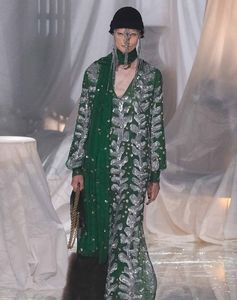All roads at Paris Fashion Week seemed to lead to India this season, even as the world’s most celebrated fashion week wound up earlier this week. India and Indians have popped up at PFW for over a decade, especially since Aishwarya Rai began to walk for L’Oreal over 20 years ago. But this season, more than before, India was on Paris’s mind.
To start with, Rai was joined by star-of-the-moment Alia Bhatt. L’Oreal’s new brand ambassador wore Gaurav Gupta even as she joined a long list of brand ambassadors for the wealthiest beauty companies in the world, including Kendall Jenner, Camila Cabello and Eva Longoria. Sonam Kapoor, a one-time L’Oreal ambassador and forever India’s fashion queen, attended the Dior runway show dressed top to toe in the brand, and styled by her sister Rhea Kapoor’s magic wand. A sparkling Ananya Panday attended the Chanel show too.
On the runway too, Giambattista Valli paid yet another homage to his favourite country: India. Valli, the former creative head of Emanuel Ungaro and now his own label, spends a lot of time here. He is often seen at Jaipur’s City Palace attending parties hosted by Padmanabh ‘Pacho’ Singh and his sister Gauravi Kumari. His haute couture collection last June in Paris was inspired by India, too, with his models streaming down in veils (two of them were Indian girls Nayonikaa Shetty and Neelam Gill) walking to Hindustani classical music.
This year, Valli took Indian block prints as well as the Mughal angrakha to the runway. The angrakha, a traditional men’s shirt, is open from the front and diagonally tied together with drawstrings on the chest and waist. Fashion blogger Aamir Ali Shah was quick to point out that Valli had used block print motifs of cypress trees, rosebuds and bootis in delicate embroidery. Shah also noted that many of Valli’s motifs were inspired by the lattice work or jaalis seen at one of the entrances of Jaipur’s City Palace.
The star of Paris Fashion Week was undoubtedly Alessandro Michele, the rockstar-level designer who worked at Gucci for seven years and tripled its fortunes (to $10 billion in 2022). This year, he made his debut at yet another legendary Italian fashion house, Valentino.
Michele’s collection for Valentino was soaked in India, especially in its kameez-style opulent tunics worn with long chiffon stoles or dupattas. They were heavily embroidered, much like north Indian wedding wear, and made South Asian influencer Diet Paratha accurately call it “so South Asian coded”. There were ornate paisley motifs, frills that resembled petticoats and soft slim pants that reminded of pyjamas.
Michele dressed the runway with broken pieces of glass, lit the room with dim lights and a shroud of white sheets, as if the label was waking up from hibernation. In the post-show conference, he spoke of founder Valentino Garavani: “We pigeonholed him as someone classic and chic. In truth, he was a revolutionary.”
Michele’s references were Roman baroque but you couldn’t separate them from Indian opulence, well in tune with his magpie mode. Kitsch jackets, chiffon trails and even nose rings. On his front row were his besties Harry Styles and Jared Leto, Elton John and Andrew Garfield.
Global collaborations are hardly new, and Dior’s Maria Grazia Chiuri has long been crediting India in her shows. Europeans have been influenced by our textiles, embroideries, prints and motifs since early 17th century. The French courts of Marie Antoinette and Josephine Bonaparte sourced fabrics from India but credited their French tailors. Givenchy and Balenciaga used sari dresses for the collections in the 1960s. The sari dress saw variations at Yves Saint Laurent, Karl Lagerfeld at Chanel, Scherrer, Alexander McQueen, Gaultier, Dries van Noten and John Galliano.
Fashion scholar Phyllida Jay’s Inspired by India: How India Transformed Global Design lists the immense influence India had on global designs. Words like chintz, bandanna, muslin, seersucker, shawl, dungarees, khaki and pyjama—all borrow from Indian languages.
X@namratazakaria


